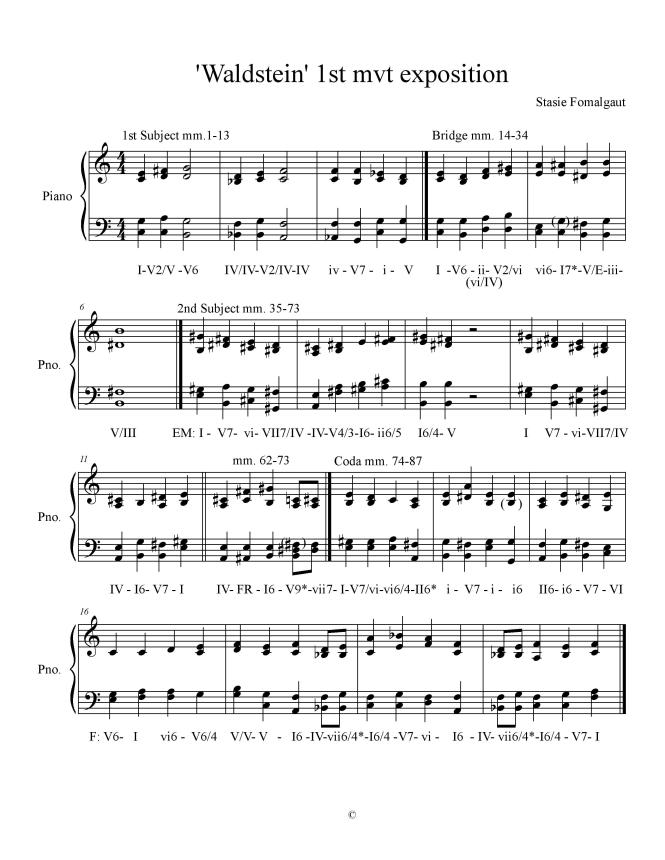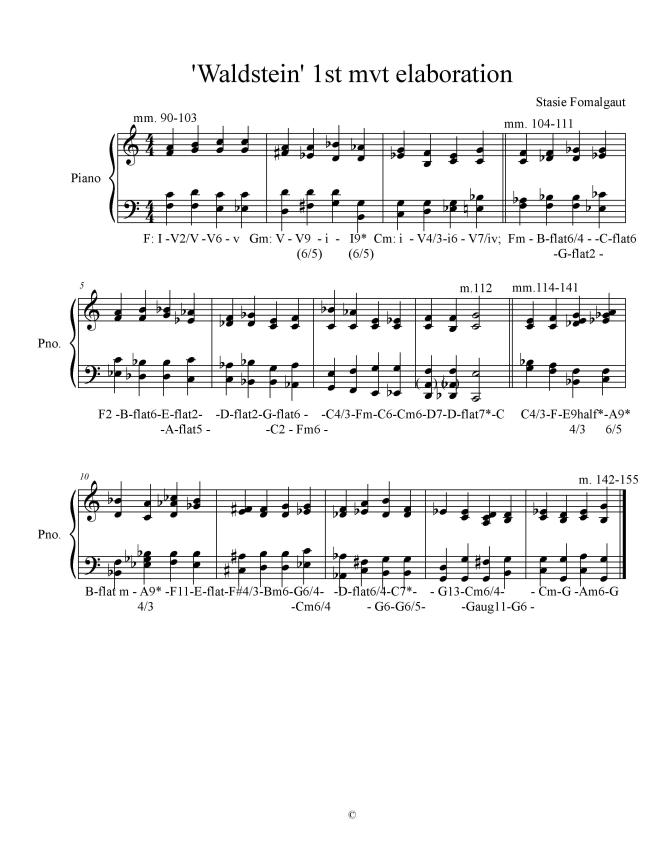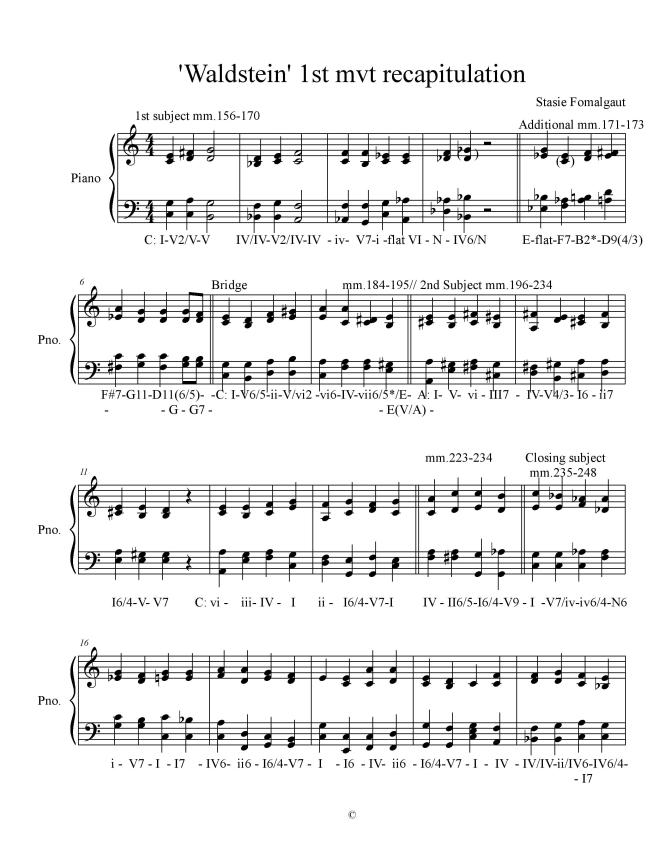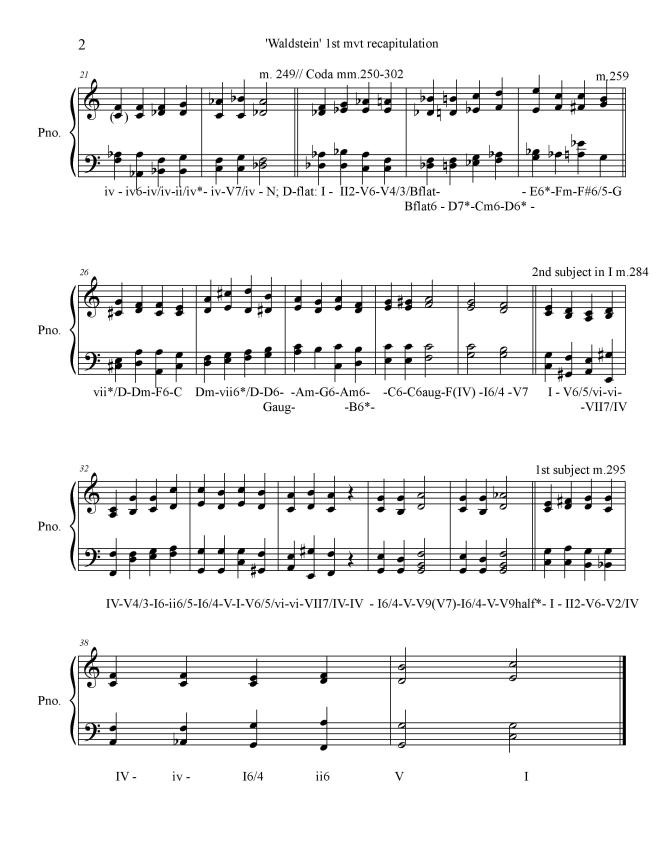“Waldstein” (1804) belongs to the middle period of the Ludwig van Beethoven’s compositions. Op. 53 is the first sonata to focus on the extensive finale movement more than on the sonata allegro; also, is the first one in line of compositions where the middle slow movement is inseparable from the finale. The energetic first movement, sonata allegro of op. 53 is organized by motivic elements rather than by the melodic development. The brief Grundgestalt, the basic shape of the piece constructs all the subjects or themes and their variations, the bridge, all connecting elements, and the coda of the composition. It appears in repeated and variated forms in different keys and note values.
The registers in this movement are extremely low on the keyboard and never exceed F of the third octave. The timbral effect of the piece is created by contrasting registers of themes: 1st theme always emerges from the depths of the piano bases, the second theme sings in the range of human voice and is melodic, and the closing subject has high scale runs in the right hand.
In this paper I’m analyzing the “Waldstein” based on the Urtext score[1] of German edition.
Identifying Grundgestalt
I think that the basic shape of the first movement of sonata op. 53 comprises of ascending and descending scale of three pitches, which first occur in measures 2 and 3 in soprano voice (m. 2: E-F#-G; m. 3: B-A-G) and later gain a fourth pitch as a variation. These running motifs construct every passage in the piece alternating between the ascending and the descending forms in 16th, 8th and 4th note values. The tail of the first subject (m.3, 4 in the right hand) is widely sprinkled over the score. The second subject contains both ascending and descending basic shapes in the soprano, tenor, baritone voices, and in bass voice in mm. 37-38 in the exposition and mm.198-199 in recapitulation episodes. The bridge has the unending runs of chromatic tails of 16th notes in the right hand in mm. 23-26 and contrasting 8th notes ascending lines in mm.31-34 (the liquidation of the bridge). The tail appears in coda of the movement identically to its appearances in the elaboration episode (the antecedent of the 1st theme is followed by modulating tails in mm.151-158). The scale runs in the coda consist of the series of ascending tails in right hand in mm.263-274, while appearing in their initial shape descending in the left hand.
The other part of the basic shape has to do with the pedal point, which permeates the whole movement: repeated or pedaled harmonies and bases occur in the 1st subject, the bridge, variations of the 2nd subject, throughout the elaboration episode and the coda. Some of the pedal points appear as repeated plain chords (1st theme in mm. 1-10), repeated tremolos (as in 2nd sentence connecting the 1st theme and the bridge in mm. 14-22), or repeated arpeggios of alternating harmonies based on the same bass tone (for example, left hand arpeggios in the bridge in mm. 23-28). Pedal points and repetitions also appear in the variations of the second theme (for example, mm. 58-60 and mm.62-73).
It must be mentioned that the most recognizable form of this sonata allegro is the closed shape of the triad with the floating 3rd in soprano voice:
Figure 1. Grundgestalt of the first movement of L. Beethoven’s sonata op.53
Subjects
The first theme of this sonata occurs in the very beginning of the movement in mm. 1-13. Pedaled bass line of the first sentence descends from C to G (C-B-A-A-flat-G) in mm. 1-9 and ends with the half-cadence in mm. 12-13. The antecedent occurs in tonic region in mm.1-4, the consequent in subdominant region in mm. 5-8, then the minor IV and V alternate in the reductions phrase in mm. 9-11. The liquidation of the 1st theme begins on the second beat of m.11 to the fermata on the half-cadence in m. 13. The tail, a repetition and variation of m. 3 and m. 7 develops in following mm. 4 and 8. In m. 9 the tail alternates between the minor IV descending and ascending scales of 5 pitches. The tail of the antecedent of the first theme serves the basis for the elaboration episode, modulating freely in mm.93-111 and pedaling the dominant scale in mm. 142-154 just before the recapitulation.
The second theme appears to be a chorale with variations. The 1st variation contains triplets in right hand in mm.43-49; the 2nd variation has triplets contrasted with the pedaled syncopations played by the opposite hand in mm.50-53; in the 3rd variation both hands play triplets simultaneously mirroring each other’s movements in mm.54-57; 4th variation speeds up by the 16th notes runs in both hands in mm.58-61 and results in variation 5 with its micro climax of the second theme in mm.66-67, and liquidation in mm.68-73.
The closing subject constructs with a citation of the tail runs from the reductions phrase of the 1st theme (m.9-10) and the citation of the chorale of the 2nd theme in the left hand. It modulates from III (E major) in m. 74 to E minor in m.78. The connecting element repeats the melodic second half of the closing subject with multiple modulations, resulting in IV (F major) in the beginning of the elaboration episode in m. 90.
Developing variation
The variation occurs when some things change, and some remain the same. The rustling ppp chords of the first sentence break into shivery 16th note tremolos when the tonic and dominant phrase of the first theme repeat in the bridge in mm. 14-22. The dominant phrase, initially in B-flat major, IV/IV, here begins in D minor, minor VI of IV, and modulates to A minor. The tail of the 1st subjects repeats one more time in m.22 with chromatic augmentation of 6th scale degree (leading tone to the following B), therefore creating a 5-measure dominant phrase.
The bridge subject begins in B major (V/III) in m.23, leading to E major of the second theme in m. 35. Pedaled bass on B constantly alternates B major and E minor 16th notes arpeggios instead of chords or tremolos in mm. 23-28. The right hand develops scale runs from the tail motif which appears from the tied B on the first beat in m.23. Mm. 29 and 30 are a culmination of the bridge (reductions phrase: mm. 27-28, liquidation of the bridge mm. 29-30). The ascending staccato 8th notes in mm. 31-34 reinterpret B (V)-E (I) harmonic alternations in the bridge and finally modulate to E major of the 2nd theme.
Tonal Problem
Tonal problem develops early in the antecedent which begins with the prolongated static tonic chords. Such lengthy statement of a simple C-major chord with the 3rd scale degree in soprano voice creates tension, which, although immediately releases into the dominant in mm. 3 and 4, builds up for something more sophisticated and simultaneously accentuates the role of E major and E minor in this movement. Without any modulation in between, the composer applies B-flat major pedaled chord in the consequent (a major subdominant of C major’s subdominant). The consequent modulates to F-major (IV in C-major). Reductions phrase begins in the minor subdominant region, related to IV as a chromatic mediant. The altering F-minor and G-major (minor subdominant and dominant) are eliminated with the syncopation of beat 2 of m. 11 with the dominant octave in left hand, and descending G-major scale in the right hand which resolve in descending C-minor chord in m.12, which only stops on the hollow G double octave in m. 13.
As the piece progresses, the listeners are taken into subdominant regions in every possible spot, – such as the beginning of elaboration episode in m.90, an incorporation of Neapolitan chord (flat 6th of the minor subdominant) in the recapitulation in m.169, the beginning of coda with the pedaled Neapolitan chord in m. 249, and the connecting chorale between the closing subject of the exposition and the elaboration episodes. The major and minor subdominant modulations were clearly a priority over the traditional dominant modulations in this sonata (also thinking of the second movement which begins with major IV going to major III). I suggest that the tonal problem of this piece elaborates on the harmonic contrast of the subdominant and the tonic regions and investigates the implementation of the chromatic mediant subdominant regions in relations to the chromatic mediant tonic.
The tonal balance is restored completely by m. 204, where the second subject sounds in C major for the first time. Before the second subject in the recapitulation, the bridge motifs appear in III (E major), which is a dominant of the chromatic submediant A major, instead of G major (dominant of C). Hence, the composer prolongs tonal tension of the piece until the chorale of the 2nd theme modulates to C major through a passing chromatic mediant to minor VI on the first beat in m. 200. The second beat of the same measure features E minor triad [chromatic mediant of V/A minor] which also serves as a leading tone to the following F major chord (IV/C). C major in m. 201 appears as a dominant to F major and is succeeded by D minor triad (minor VI of major IV). Only in m.202 the C6/4 chord leads to the actual restorations of C-major tonality.
Musical Idea
A repetition of material allows the diverse tonal, motivic, and rhythmic variations to occur naturally. The contrast between static but energized pedal points, repetitions of motifs and harmonies, and the running scale passages create the unique texture of the massive sonata allegro movement. Paired with the centrifugal tonal tendencies of the piece (the applications of subdominant and submediant regions), the prolongated repetitions of singular chords and motifs create the perpetuum mobile effect of the piece. The timbral contrast of low, human, and high registers in soft dynamic range suggests a space where the murmuring pedaled low chords and running tails and scales deserved a nickname “Aurora” (Latin ‘morning star’) to the composition.
Appendix A: Tonal reductions




[1] G. Henle Velrag. Beethoven: Klaviersonaten, Band II, pp. 88-101.

